Any Eastern European knows the comfort and joy that comes with fresh potato pancakes. Packed with potatoes, onions, eggs, and spices, they’re just perfect!
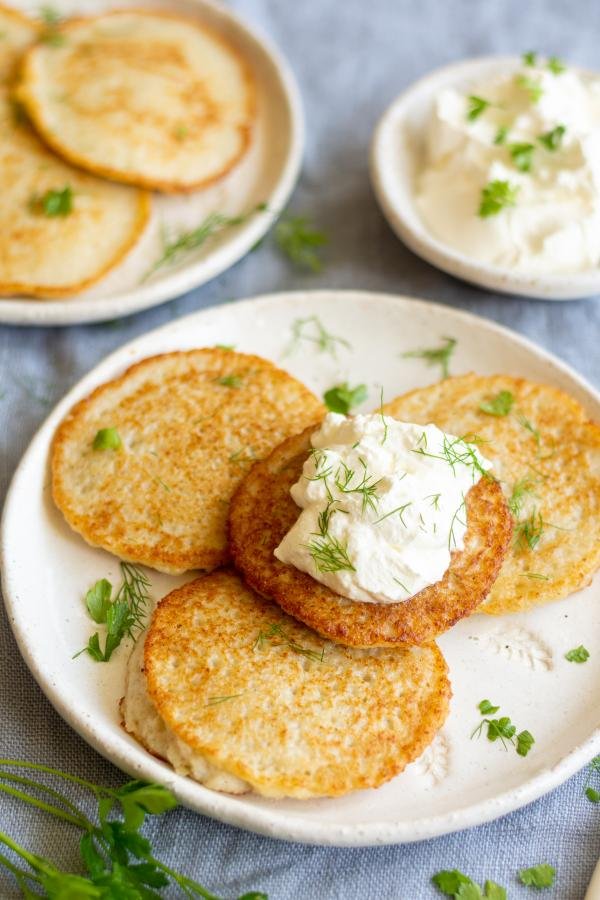
One of my fondest memories of growing up in Ukraine was preparing potato pancakes. After each potato harvest, my siblings and I would take turns grating potatoes for hours on end in anticipation of getting to sink our teeth into one of our favorite treats. When it came time for my mother to cook the pancakes, I would often ask her to fry mine a bit longer to make the edges extra crispy. If you love unique pancakes, give our ricotta pancakes or oladi pancakes a try, too!
Note: While you can always grate the potatoes by hand using a cheese grater, we typically use a blender or food processor to speed the process up significantly!
The Difference Between Potato Pancakes & Latkes
Oftentimes latkes and potato pancakes are referred to as the same thing. Although similar, they do have stark differences – especially when it comes to texture.
- Potato Pancakes: Potato pancakes require you to grate potatoes on the smallest slots of your grater. This is more time-consuming and results in a liquid-like pulp. To speed things up, I use a blender or food processor. You then combine the potato pulp with eggs, onions, and a dash of seasoning. The result is similar to a traditional pancake – round, fluffy, and smooth in texture.
- Latkes: Latkes require you to grate potatoes on the larger shreds. Typically, latkes are made with the same ingredients as potato pancakes, except for the addition of flour or matzo. The result is an irregularly shaped pancake that is crunchier in texture due to the larger shreds of potatoes.
Choosing the Right Potatoes for Potato Pancakes
Russet potatoes are by far the best potato for making potato pancakes. They have a superior level of potato starch (hello, crispy outer crust) and are incredibly cheap. Typically, you can get a 5-pound bag of russets for just a couple of bucks! In a pinch, you could probably use Yukon gold potatoes, but the starch level just isn’t the same.
Potato Pancakes Video
How to Prepare Authentic Potato Pancakes
Preparing perfect potato pancakes is a very straightforward process – all you have to do is grate the potatoes, season the batter, and fry it in pancakes until golden brown.
- Prepare the Potatoes: First, skin potatoes and peel the onion. Grate the potatoes with a box grater into a large bowl or quickly grate them with a blender, food processor, or a grinder.
- Season the Pancake Batter: Next, add the eggs into the bowl with the potatoes and season with a generous amount of salt and pepper. Stir until well-combined.
- Fry the Pancakes: Then, preheat a skillet with oil over medium heat. Using a tablespoon, portion small amounts of the potato mixture into the pan. Fry each side until golden brown and enjoy immediately!
Hot Tip: Add a little garlic powder to the potato mixture if you like it zesty!




5 Tips for Making Potato Pancakes
Follow these simple tips to help you get a perfectly crispy potato pancake with a soft silk center.
- Drain out any excess liquid. After shredding your potatoes into a big bowl, drain the liquid that gathers at the bottom. Too much liquid prevents the pancakes from crisping up and turns them soggy. You can even place the potatoes into a cheesecloth and wring out the excess liquid even more.
- Adjust the salt to taste. Don’t be afraid to play around with the salt levels until you reach a level that works for you. Some people like to do light salt because they use saltier toppings, while others opt for a dollop of sour cream and a saltier pancake.
- Test one pancake first. Start by testing one pancake in your oil. This will give you a good idea of whether or not you need to turn the heat up or down on your skillet.
- Don’t over-flip your pancakes. Try to refrain from over-flipping your pancakes. You want them to develop even crispiness on the outside. Fiddling with them too much will cause them to fall apart and become a mess. Patience is the key!
- Drain the excess grease on a wire rack. Invest in a drying rack (don’t forget to put a paper towel underneath it!). This will help drain off the extra oil from your pancakes, keeping them crispy, and not soggy.

Serving Suggestions
If you want to be a traditionalist, serve your potato pancakes with a dollop of fresh sour cream or some milk at brunch. You can also top them with pieces of cold smoked salmon, dill sauce, and minced dill or green onion. They also make for a wonderful side dish topped with applesauce and sour cream and served alongside various proteins like air fryer pork chops, Thanksgiving turkey, or spatchcock chicken.
Serving these pancakes to kids? Our boys love them topped with cheddar cheese and bacon bits.
Storing & Make-Ahead Tips
Whether you are celebrating Hanukkah or just making potato pancakes for friends and family, you can make your life easier by preparing them ahead of time.
- Refrigerator: To keep your potato pancakes on hand for up to a week, keep them stored in an airtight container in the fridge. To do so, fry your pancakes up and let them cool down completely. Then, store the pancakes in an airtight container, separating each layer with parchment paper to prevent sticking.
- Freezer: If you want to freeze your pancakes for later snacking, store them in an airtight container, separating each layer with parchment paper. Freeze them for up to two weeks.
Reheating Potato Pancakes
When you are ready to serve refrigerated pancakes, preheat your oven to 350°F and lay the pancakes on a baking sheet for about 5 minutes or until they return to their deliciously crispy state! To reheat frozen pancakes, bake them in the oven at 400°F for 10 minutes.
More Tasty Potato Dishes to Try
- Oven-Roasted Potatoes – 3-ingredient roasted potatoes
- Ranch Roasted Potatoes – Zesty, 3-ingredient roasted potatoes
- New Potatoes with Bacon & Herbs – Whole baby potatoes with dill and salty bacon
- Mashed Potato Pancakes – A delicious way to use up leftover mashed potatoes.
- Crispy Smashed Potatoes – Parmesan, bacon & herb smashers
Recipe
Ingredients
Instructions
- Skin potatoes and peel onion. Use a large bowl and grate potatoes and onions on small slots. You can also use a blender, food processor or a grinder.
- Add eggs to the mixture, season with salt & pepper. Whisk to combine everything together.
- Preheat skillet with oil on a medium heat. Place batter with a tablespoon into the skillet.
- Fry each side until it's golden brown.



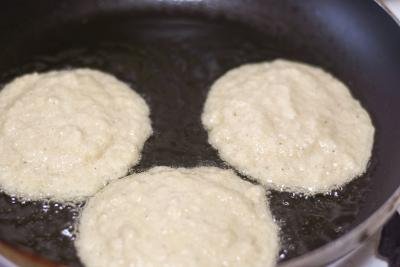
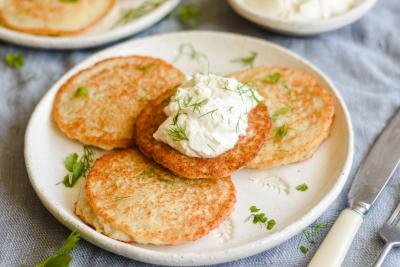
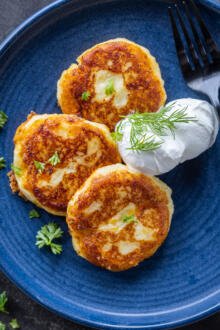

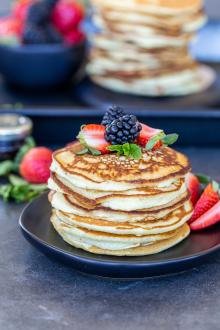



Hi, for decades I had the best recipe for soft potato pancakes. It was written on a little piece of paper in my overstuffed recipe box. I haven't used it for a while and now I have no idea where it is. So I've been searching and searching for a soft shredded potato potato pancake. Your photo looks exactly like the ones I was hoping to make. Unfortunately they turned out nothing like what I think they should have and nothing like what your picture shows. I basically just made some clumps of hash browns. I went exactly by your recipe. Apparently you don't use flour in this recipe so I did not put any flour in it. Really disappointed!
Hi Corinne- I'm sorry to hear the recipe didn't meet your expectations. You are correct that I don't add flour- some potato pancake recipes do, but mine doesn't. I do have a latkes recipe that uses flour, maybe that is something closer to what you are hoping for? Best of luck!
My family is Slovenian. We always used the large grater to grate onion n potatoes. I recently went into a Jewish restaurant in NY. They did use large grated potatoes. If you check Manschwich lake mix, its a powder. They also deep fry them. So I know of the recipes to be the opposite of yours. Interesting.
That is interesting! I do think lots of places do it different - this is just how my grandma always made them! Thanks for sharing, Amelia!
I always think to myself if I could go back in time I would go back to my Grandma’s kitchen for her potato pancakes that were just like these. We however did not use sour cream. We used butter! So good. I share your passion for potato pancakes.
Mmm buttery goodness! These potato pancakes are definitely nostalgic! Thanks for sharing, Lily!
Can you use leftover steamed potatoes instead of raw?
Hi John, the texture would be completely different. I think for steamed potatoes, this recipe would work really well! https://momsdish.com/mashed-p…
Made them tonight. Tasted really good. Just like remembered from long ago but am thankful for food processor now days 🙂 I place everything in food processor and added 2 Tbs flour (that's how my mom made them), and sprinkled over with regular sugar.
Thank you for the simple recipe 🙂
I don't like latkes but like potatoes pancakes.
Thanks Ellie! I'm glad they were similar to the ones you ate long ago! I love it when food reminds me of some good ol' memories!
Instructions never add the onions
Hmm, the first step includes grating the potatoes and onions. Did you miss that, or are you referring to something else?
Your potato pancakes look delicious. I'll make them for my husband this weekend as he loves potato pancakes (he is Belgian). There is a German restaurant near us and they make potato pancakes differently than I've seen anywhere on the internet. Their potato pancakes are thin pancakes with fried, grated potatoes in the center. They are delicious. Are you aware of any recipes like this?
Hey Cynthia! Thank you! I'm thrilled you're going to make the potato pancakes for your husband—I'm sure he'll love them! As for the style you mentioned from the German restaurant, it sounds like a they could be called Reibekuchen. I don't have a recipe for those specifically, but we have a classic potato latkes recipe on our blog that you should look at as well. I hope you find something that reminds you of that restaurant, and please report back if you try one of our potato pancake recipes!
My Mom used to make these when i was growing up every Friday…..Always looked forward to Friday dinners! We used to sprinkle sugar on top….has anyone else eat them this way??
That's the only way I eat them. Sprinkle of granulated sugar then a quick dip in apple sauce and sour cream 😋
Wait what.... Sugar? And Apple Sauce?! I have never tried that.
Hi Sharon, that sounds like a fun tradition. I have never tried them with sugar, they were more of a savory meal for us. Now I wonder who tried them this way 🙂
How many cups of shredded potatoes are you expecting to get . I ask as potatoes are all different sizes. Or are you looking at about 2.5 lbs worth?
Hey Ellen, Great question, but I just look for the largest 5 potatoes, or if they're smaller use a bit more. This recipe is pretty forgiving, so there's no need for an exact weight or measurement regarding the potatoes. I think 2.5 lbs of potatoes will be just fine! I hope this helps, and enjoy the potato pancakes!
This is the recipe my Mom used to make the potato pancakes every Friday for dinner when i was growing up……making them very crispy ……Has anyone put sugar like we did sprinkled on top?
What a lovely memory! Thanks for sharing with us. I love that these crispy potato pancakes are so nostalgic. I prefer them savory, but I can see how some would like a sprinkle of sugar on top!
These sound really amazing. I do have one question though. Do you cook the potatoes first?
Hey Cindy, No, potatoes are not cooked, they are grated raw. I hope you try these pancakes soon, and I look forward to hearing back from you!
I make them to use up leftover chili. Lay them out on your plate, a ladel or two of chili, and some shredded cheddar. It's killer.
That sounds delicious Bryan. Thanks for sharing!
My mom made the best potato pancakes. As kids we topped them with butter and S&P.
Hi Joe, Mom's pancakes are always the best! Thanks for sharing this sweet memory with us.
This is a classic Hanukkah dish. Potato Latkes. All time favorite.
We usually squeeze as much liquid as possible before adding eggs.
This step will make potato much cruncher. I like that there is no call for baking soda or flour in the recipe.
Love your recipes. Thank you for keeping website going.
Hi Lia, we didn't squeeze out liquids when we made them growing up and they had crispy edges while soft in the center. One of the favorite meals growing up. But we do have more of traditional Latkes here: https://momsdish.com/potato-l…. Thanks for sharing your feedback.
Great recipe - my grandma would make these when we were little and I've thought about them ever since. When I saw your recipe I knew I had to try it. They were just like I remembered them!
Hi Melissa- Ah, I love hearing that. Nothing like childhood comfort food 🙂
We loved these! It was my kid's first time having them and he gobbled them up so quickly!
Hey Erin- so glad he loved them. I was this way as a kid too- they went faster than my mom could cook them! 🙂
These potato pancakes are out of this world! My family loved them! Thanks for sharing!
Hey Katerina- thank you for giving them a try! They are a family favorite for us as well. 😀
My German mother in law taught me how to make these. One of our favorites. She always served them with canned cranberries on toI or cooked Apple's. I prefer the cranberries..
Christine, this sounds incredible. I love the idea of adding canned cranberries.
I make some of this and my boss like it
Hey Daphnie, your boss is a lucky person!
What kind of potato should be used?
My favorite potatoes for potato pancake recipe is are Yukon Gold. But you can also use Russet potatoes as well.
These are so delicious! Love how they cook up!
Suzy, thank you so much much!!! I am so glad you loved them 🙂
Love this recipe! Potato pancakes are always a hit.
Katie, thank you! I am so happy you loved them!
Yum! My whole family loves these!
Krissy, thank you so much for sharing. I am glad your family loves this recipe.
Who knew these were so simple to make? This is my kind of comfort food!
Yes, so easy! Plus having a food processor or a blender really helps.
This was such a fun change to our normal routine. My kids loved them!
Jen, thank you! I am so glad you loved them. 🙂